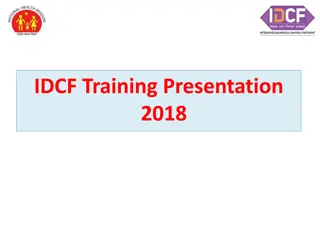
Rural Health Policy and Research Insights by Dr. Ty Borders
Explore key research findings by Dr. Ty Borders on rural health policy and access challenges. Learn about the unique issues rural areas face, the importance of regionalization, and the link between mental health and substance abuse. Gain insights on preferred drug treatment sites and the critical connection between mental health and opioid misuse.
Download Presentation

Please find below an Image/Link to download the presentation.
The content on the website is provided AS IS for your information and personal use only. It may not be sold, licensed, or shared on other websites without obtaining consent from the author. If you encounter any issues during the download, it is possible that the publisher has removed the file from their server.
You are allowed to download the files provided on this website for personal or commercial use, subject to the condition that they are used lawfully. All files are the property of their respective owners.
The content on the website is provided AS IS for your information and personal use only. It may not be sold, licensed, or shared on other websites without obtaining consent from the author.
E N D
Presentation Transcript
Contemporary Issues in Rural Health Policy and Research Ty Borders, PhD Professor Foundation for a Healthy Kentucky Endowed Chair in Rural Health Policy Director, Rural and Underserved Health Research Center Editor, The Journal of Rural Health
Conducts research to inform decisions about how to organize health services facilitate access improve population health In rural and undeserved rural areas Cooperative agreement # U1CRH30041
4 Key Points 1. Not all rural areas are alike 2. Low capacity, consumer preferences require regionalization 3. Mental health and substance abuse are inextricably linked 4. Need to move beyond rural / urban comparisons
2. Low Capacity and Consumer Preferences Require Regionalization Small capacity constraints in rural areas Insufficient demand for low volume, specialized services Lower availability of providers Even telehealth relies on providers at another location Many rural residents prefer non-local care Migration/travel for physician and hospital services Example of preferred drug use treatment site 1Borders et al. JRH 2000; 2Borders et al. HCMR 2001; 3Radcliff et al. JRH 2003; 4Xu & Borders JRH 2003
Preferred Drug Use Treatment Site 20.2 Rural In town where live 22.2 57.6 In other town nearby 57.1 In other town farther away Urban 9.1 33.8 0 10 20 30 40 50 60 70 80 90 100 % % Borders et al. Journal of Substance Use Treatment, 2015 NIDA grant to Borders
3. Mental Health and Drug Abuse Are Inextricably Linked, but Undertreated
Suicidal Plans and Ideation by Opioid Misuse (%) 3.55 No opioid misuse 25.82 Suicidal Ideation Suicidal Plans 14.88 Opioid misuse 36.51 0 10 20 30 40 Suicidal Ideation P<.0001 Suicidal Plans P=.0057 %
Prevalence of Treatment Utilization among Persons with a Drug Use Disorder 30 26.67 24.25 24.13 25 21.4 20 17.85 13.94 % 13.7 15 13.05 12.5 12.4 11 10.8 10 5 0 Metro Non-Metro Metro Non-Metro Any Drug Use Disorder Opioid Use Disorder Treatment Use 2008-2010 2011-2013 2014-2015
4. Need to Move Beyond Rural / Urban Comparisons Pros of R/U comparisons: Easy to understand and use Cons of simple R/U comparisons: R/U based on # of persons in arbitrary geopolitical boundaries R/U is a proxy for other factors Health system (could be modified by policy) Economics (could be modified by policy) Social and demographics Borders TF. Advancing the field of rural health research: moving beyond simply documenting rural vs urban differences. Journal of Rural Health. 2017;33(1):3-4.
Concluding Comments Not all rural areas are alike Need rural-oriented policies Most innovation will come at the state level Acknowledgments Some of the information in this presentation was supported by the Federal Office of Rural Health Policy (FORHP), Health Resources and Services Administration (HRSA), U.S. Department of Health and Human Services (HHS) under cooperative agreement # U1CRH30041. The information, conclusions and opinions expressed in this document are those of the authors and no endorsement by FORHP, HRSA, HHS, or the University of Kentucky is intended or should be inferred.






















